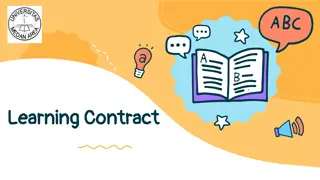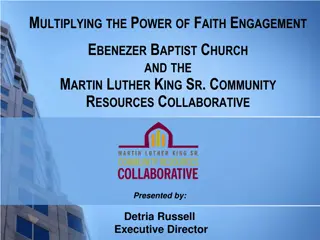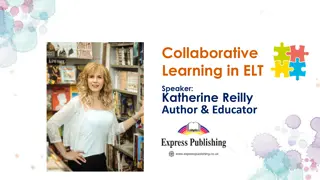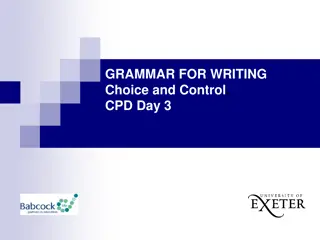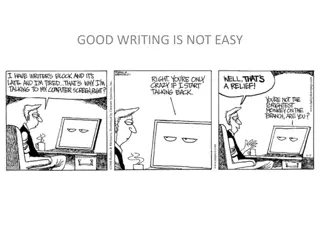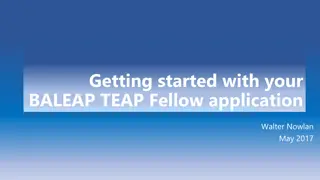
Evaluation of Role Assignment in Collaborative Writing Tasks Using Scale-Up Approach
Explore the role assignment approach in collaborative writing tasks with the Scale-Up method, focusing on student perceptions, roles based on Heller and Heller, and a model of collaboration. The analysis delves into equality, engagement, language-related episodes, and the adoption and usefulness of different roles.
Download Presentation

Please find below an Image/Link to download the presentation.
The content on the website is provided AS IS for your information and personal use only. It may not be sold, licensed, or shared on other websites without obtaining consent from the author. If you encounter any issues during the download, it is possible that the publisher has removed the file from their server.
You are allowed to download the files provided on this website for personal or commercial use, subject to the condition that they are used lawfully. All files are the property of their respective owners.
The content on the website is provided AS IS for your information and personal use only. It may not be sold, licensed, or shared on other websites without obtaining consent from the author.
E N D
Presentation Transcript
A CRITICAL EVALUATION OF ROLE ASSIGNMENT IN COLLABORATIVE WRITING TASKS THAT USE A SCALE-UP APPROACH Walter Nowlan, Nottingham Trent University Image taken from Nottingham Trent University, 2017. http://www4.ntu.ac.uk/adq/teaching/experimental-teaching-rooms/scale-up/index.html
SCALE-UP Student-Centred Active Learning Environment with Upside-down Pedagogies (Beichner et al., 2007) Students apply their knowledge through collaborative group tasks. 'upside-down' teaching. Content is encountered outside class. Sessions are devoted to applying ideas Room design and equipment to foster collaboration Image taken from Nottingham Trent University, 2017. http://www4.ntu.ac.uk/adq/teaching/scal e_up/support_resources/index.html
SCALE-UP Roles Based on Heller and Heller (1999) ROLE PURPOSE Manager Keep the group on track Make sure everyone participates Watch time spent on each step Reporter Record decisions of the group Check that all members understand and agree. Critic Ensure group does not reach agreement too quickly Ensure group explores possibilities Suggest alternative ideas
Student Perceptions of SCALE-UP Sometimes the level between students is different. Sometimes someone came with me. He s better than me. And he would work and I would stand watching. I would do nothing. Sometimes someone is weaker than me. I work alone.
Model of Collaboration (Storch, 2013)
Method Session Aspect of collaboration Task Type Baseline None Selecting and paraphrasing suitable info from a text Select suitable info from three texts to complete a synthesising grid Use scaffolded notes to summarise an excerpt from a source text Select information from a source text to write a paragraph in response to an essay question. Treatment 1 SCALE-UP roles Treatment 2 Storch model Treatment 3 Review of Storch model and functional language for SCALE-UP roles
Analysis Equality and Engagement Equality and Engagement Who speaks, decides, has authority Language Related Episodes (LREs) Simple and Elaborated (Swain and Lapkin, 1998: 328.) Content Listening to others Roles Roles SCALE-UP roles adoption and usefulness Other roles adoption and usefulness
Some examples Treatment 1 Treatment 2
Levels of Contributions Baseline and Treatment 1 - very unequal one or more group members dominated Became more equal after Treatment 2.
Levels of Mutuality/Engagement Simple Reporters and weaker students (to signal agreement or understanding) Elaborated more LREs by all students from Treatment 2 onwards Content very little discussion of ideas in the texts. Listening Dominant students did not listen to weaker ones. Some groups did not listen to each other. Improved after Treatment 2.
Mapped collaboration 1,2,3 = Baseline P A, B, C = Treatment 1 Q R 3 Q, P, R = Treatment 2 A C B 2 1
SCALE-UP Roles Did not improve collaboration in Treatment 1 Confusion about roles negatively impacted on collaboration: Scribe passive recorder / decision-maker Manager more like decision-maker. Some roles out of reach of weaker students Role fluidity
Some Emergent Roles Teacher/Clarifier Questioner Motivator Commenter / Confirmer Justifier
Thoughts SCALE-UP roles convenient but perhaps useful as behaviours/tools that all students can use. Introduce Storch s model early Focus on what students can do to collaborate more effectively (e.g. question, comment, confirm, justify, explain).
Beichner, R. J., Saul, M., Abbott, D., Morse, J. J., Deardorff, D. L., Allain, R. J., Bonham, S. W., Dancy, M. H. and Risley, J. S., 2007. The Student Centered Activities for Large Enrollment Undergraduate Programs (SCALEUP) Project. Research-Based Reform of University Physics. [Online] Available at: http://www.compadre.org/per/items/detail.cfm?ID=4517 [Accessed April 2017]. Heller, P. and Heller, K., 1999. Cooperative Group Problem Solving in Physics, University of Minnesota. [online] Available at: http://groups.physics.umn.edu/physed/Research/CGPS/GreenBook.html [Accessed April 2017]. McNeil, J., Borg, M., Kennedy, E., Cui, V., Puntha, H., 2015. SCALE-UP Handbook [Online]. Available at: http://www4.ntu.ac.uk/adq/document_uploads/teaching/181133.pdf [Accessed April 2017]. Storch, N., 2013. Collaborative Writing in L2 Classrooms. Bristol: Multilingual Matters. Swain, M. and Lapkin, S. 1998. Interaction and Second Language Learning: two adolescent French immersion students working together. The Modern Language Journal. 82 (3), pp. 320-337.

